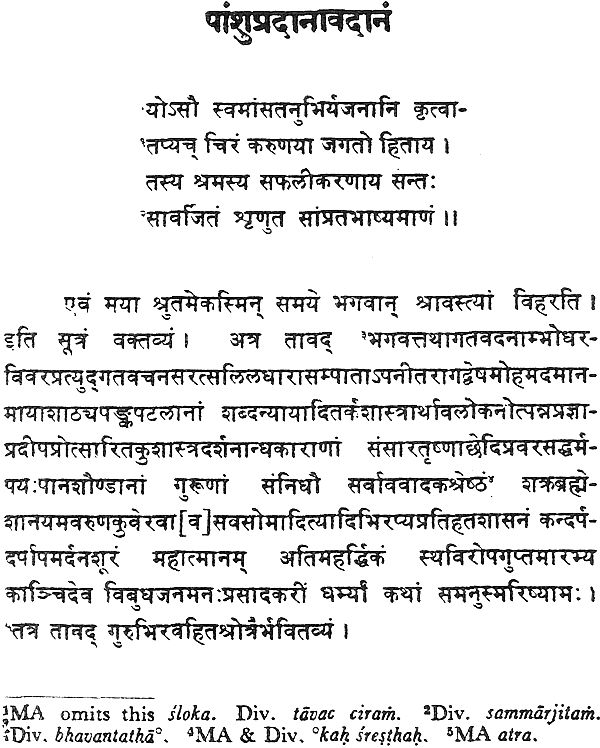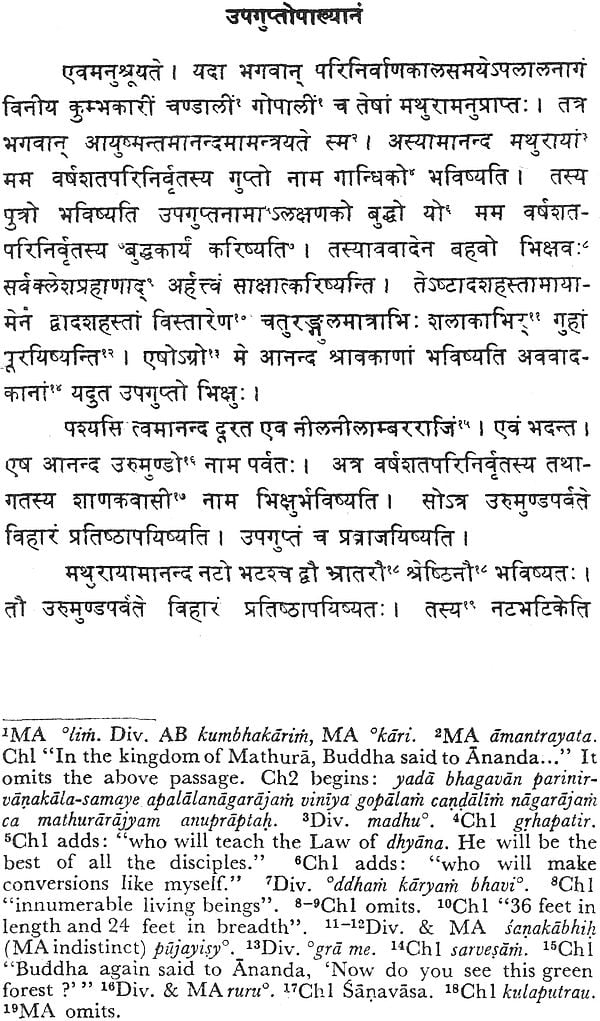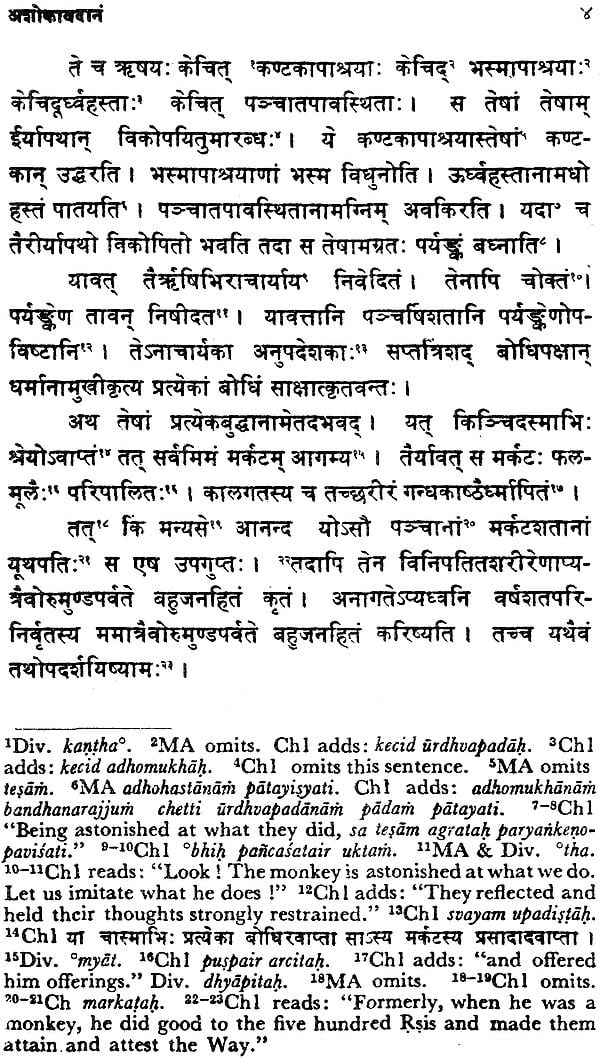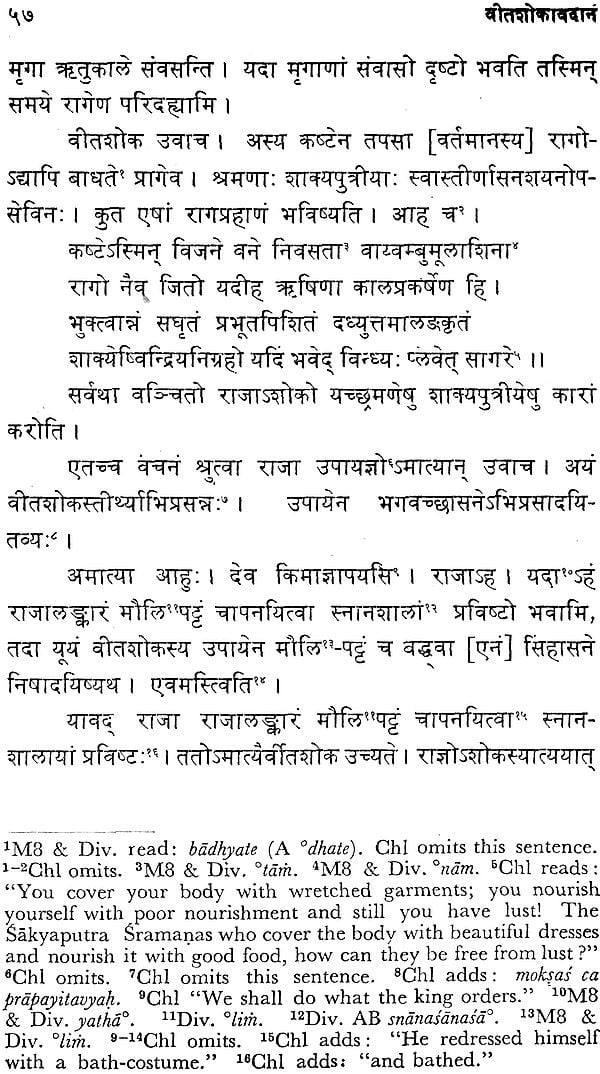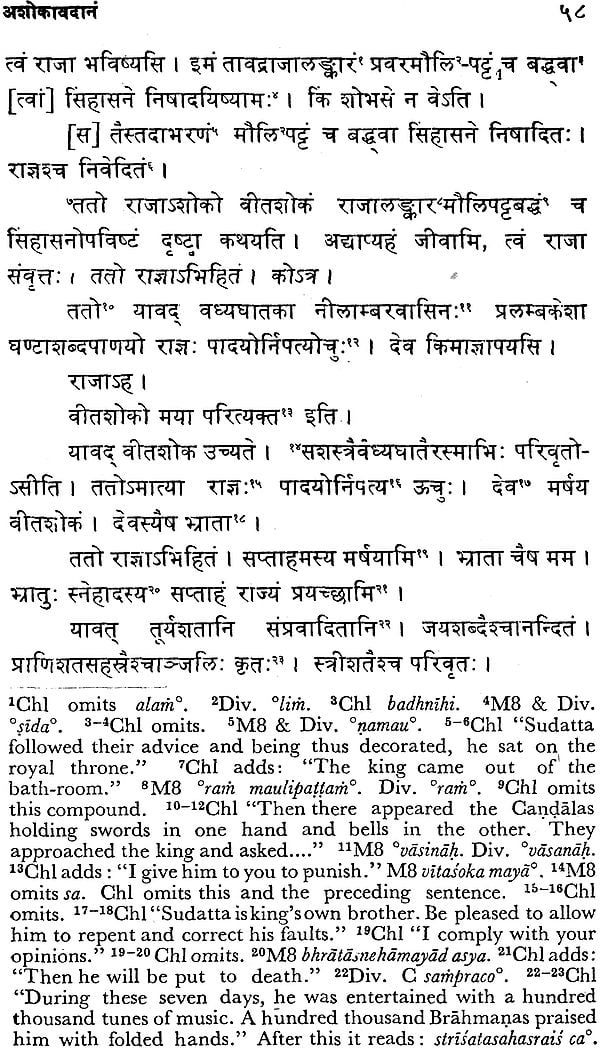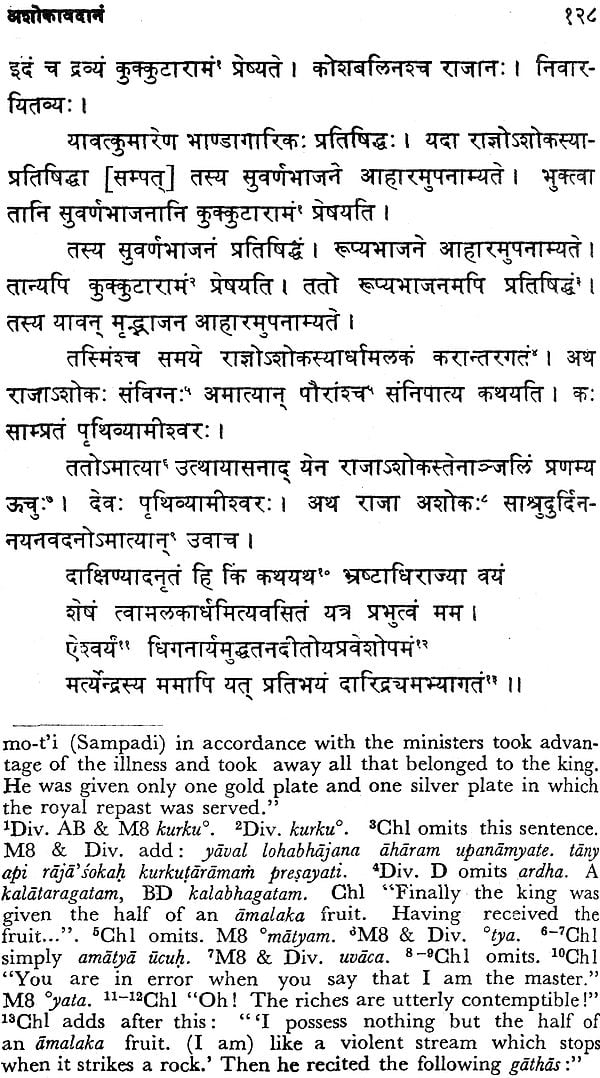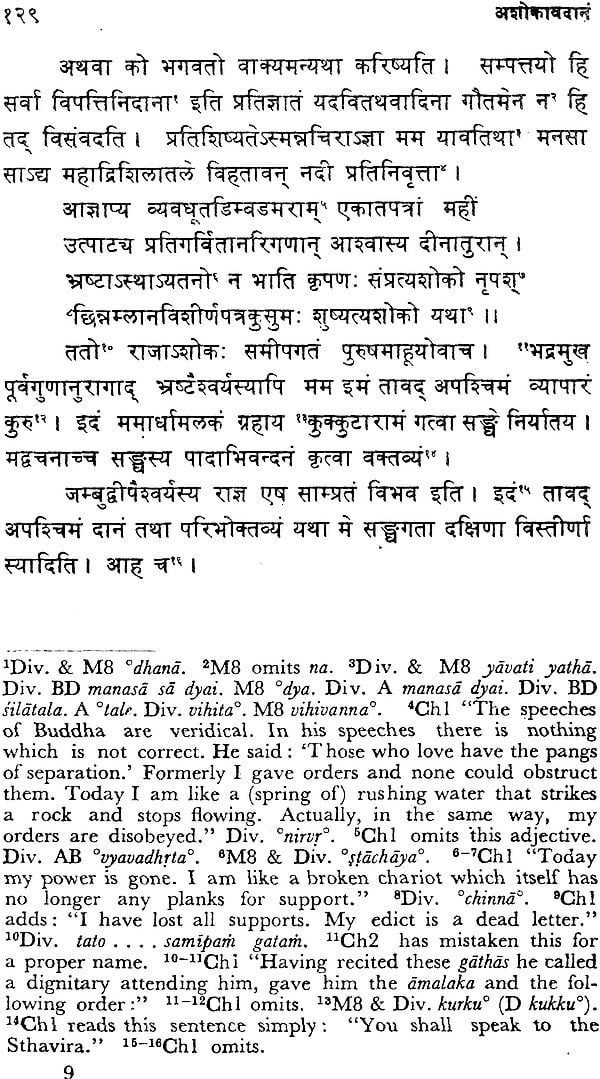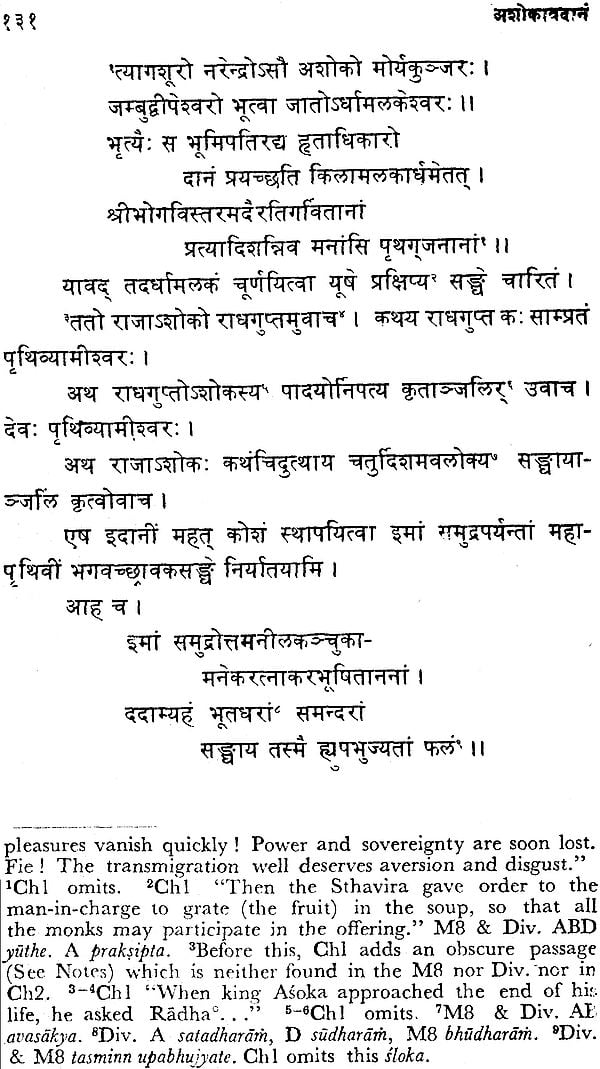
The Asokavadana (An Old and Rare Book)
Book Specification
| Item Code: | NAN422 |
| Author: | Sujit Kumar Mukhopadhyaya |
| Publisher: | SAHITYA AKADEMI, DELHI |
| Language: | Sanskrit Only |
| Edition: | 1982 |
| Pages: | 257 |
| Cover: | Hardcover |
| Other Details | 8.5 inch x 5.5 inch |
| Weight | 320 gm |
Book Description
The original Sankrit text of the Asokavadana was published for the first time in 1886. Messre Cowell & Neil intluded it in the Divyavadana.
No attempt had been made to re-edit this important and ancient text for almost a century. That the Sanskrit text is very old is proved by the fact that the first Chinese translation was made by Parthian Fa-ch’in A. D. 300. The work rapidly became popular in China and other scholars made fresh translations at various times. As late as A.D. 506-523 Sanghabhara revised the whole of the text.
Prof. Sujitkumar Mukhopadhyaya of Visva-Bharati who has edited and published a number of old Sanskrit texts comparing them with their Chinese and Tibetan translations has edited the Asokavadana, critically comparing it with its oldest Chinese versions.
The Asokavadana has thus been made available in an authoritative and accurate form. It is enriched by a scholarly introduction in English, translation of certain sections, and various Appendixes and Notes which, it is hoped, will be found useful.
The original Sanskrit text of the Asokavadana was edited by E. B. Cowell and R. A. Neil and published for the first time in 1886 (if. The Diyavadana). Unfortunately it was full of corrupt readings.
Nearly for a century there was practically no attempt by any scholar, either from the East or from the West, to revise and re-edit this important ancient text.
The text of the Asokavadana was translated into Chinese by different translators in different times. The oldest translation was made by Parthian Fa-ch'in circa 300 A.D. (cf.A-yu-wang-chuan, Nanjio No. 1459). The work •became rapidly popular in China. Even as late as 512 A.D., it was re-translated by Sangha-bhara or Sanghavarman (cf. A-yu-wang-ching, Nanjio, No. 1343).
That the Sanskrit text is very old may. be evidenced from the earliest Chinese translation of the work. It must have been written in the second century A.D.
I am glad to note that Prof. Sujitkumar Mukhopadhyaya who has already edited several old Sanskrit texts, comparing them with their Chinese and Tibetan translations has edited the Sanskrit text of the Asokavadana critically comparing it with its oldest Chinese version.
In this connexion, I should mention here that J. Przyluski translated the above mentioned oldest Chinese version into French and published it from Paris in 1923. Prof. Mukhopadhyaya, the present editor of the Asokavadana, has utilized this translation along with the original.
Mainly with the help of this Chinese translation and occasionally with others, Prof. Mukhopadhyaya presents before the Scholars a correct edition of the Asokavadana.
The edition is enriched with a scholarly Introduction in English and various useful appendices and notes. The variant readings of the MSS. and the Chinese versions are faithfully recorded in the footnote.
The Introduction contains:
(i) A synopsis of all the chapters.
(ii) English translation of the select pieces.
(iii) Textual criticism.
(iv) A discussion on the life of Asoka, historic and legendary.
(v) A discussion on the Sanskrit MSS.
(vi) A discussion on the Chinese Translations.
(vii) A discussion on the date and author.
(viii) A discussion on the meaning and significance of the word avadana.
(ix) A discussion on the striking resemblance between the composition of three stories of the Sutralankara (the original of which is lost; the Chinese translation and a French translation from the Chinese are available) and those of the Asokavadana.
The Appendixes contain:
(i) Life of Asoka based on epigraphic records.
(ii) A chronological scheme of Asoka's reign.
(iii) A chronology from the legends.
(iv) A few important Asoka Inscriptions.
(v) Explanation of difficult technical terms, and peculiar words, references etc.
From the above list of topics it will be clear that this scholarly edition will create interest even among the lay public. Fe scholars, it is important as one of the oldest, 'post-Vedic pros compositions, and as a collection of old legends some of which are enriched with noble ideas, high ideals and beautiful composition
In 1886, E. B. Cowell and R. A. Neil published the Divyavadana from Cambridge. It contained among others the old text of the Asokavadana. This text, like others of its kind, is written in Sanskrit. It consists of four chapters or sections, each of which is also named Avadana in the MSS., viz. (i) Pamsupradanavadana, (ii) Vitasokavadana, (iii) Kunalavadana and the (iv) Asokavadana.
The first one contains several legends: one of Upagupta, the spiritual teacher of king Asoka, one of Sanakavasin, the teacher of Upagupta, another of Vasavadatta the courtesan, the first convert of Upagupta. Still another, and a very interesting one, is the story of the conversion of Mara by Upagupta. The last is the legend of, Asoka, the cruel one (Candasoka) and his conversion.
The Pamsupradanavadana or the "Avadana of the Gift of Dust' is named so because Asoka, in his former existence, while he was a child once offered with great respect a handful of dust to Buddha innocently assuming it to be saktu (powdered barley). The great merit which the. boy acquired by this 'gift of dust' made him in his subsequent existence the emperor of vast Jambudvipa. Asoka is described as a very cruel person in his youth who killed men and even women whenever he found fault with them. So for his dreadful deeds he was called the Candasoka. He was gradually changed by the influence of the Buddhist Sramanas. One of them, named' Samudra in his lay life (the name he bore in his monastic life is not given), was the first to influence the young emperor. Ultimately, because, of his manifold meritorious deeds, Candasoka was given the epithet of Dharmasoka.
The second, the Vitasokavadana, is the 'legend of Vitasoka, the younger brother of king Asoka who was at first devoted to the heretics. He used to taunt the Buddhist Sramanas and pity Asoka because of his devotion towards them. Later on, however, he embraced Buddhism and renounced the world. The tragic death of this beloved brother, caused involuntarily and indirectly by Asoka, moved .him so that he changed' thoroughly.
The third, the Kunalavadana too consists of several legends. It begins with the interesting story of how Asoka humbled his minister Yasas. After this it relates the story of the great meeting of Upagupta and Asoka. The teacher Upagupta led the disciple Asoka to the sacred places where the prince Gautama was born and brought up, practised austerities and attained Enlightenment; where he turned the 'Wheel of the Law'; where he breathed his last; where the great disciples Sariputra, Maudgalyayana, Kasyapa, Ananda and others left their last remains-the relics. Then the legend of the queen Tisyaraksita who in envy attempted to destroy the Bodhi-tree is told and the story of the meeting of Asoka and Pindola Bharadvaja, a direct disciple of Buddha. After this, it relates the story of Kunala which is one of the most pathetic stories ever written. The queen Tisyaraksita, like queen Kaikeyi of the Ramayana was granted a boon by the emperor. In virtue of this boon, Tisya became the queen empress of vast Jambudvipa for a week. As soon as she came to the throne, she commanded the eyes of the prince Kunala (her step-son) to be plucked out. This order was duly sealed and despatched to Taksasila (Taxila) where the prince was staying. The lovelyeyes, blue like the rare blue lotus, were plucked out. King Asoka did not know of it. Later, when he met his blind son he was furious and wished to punish the queen with death. But the compassionate prince repeatedly implored him to forgive her. She was however not forgiven.
The Asokavadana, the fourth chapter, describes how the great emperor spent the last days of his life. He was practically interned in his bed-chamber. It is a great tragedy that the emperor of a continent, a man who once used to distribute gold coins worth millions in charity had not a penny at his own disposal. He who had always been served in gold plates had them taken away, lest he might send them as gifts to the monastery. He had to take his meals in the earthen pots.
This chapter, embellished with poems that are jewel-like may be considered one of the best compositions of ancient literature. The Asokavadana is a very important text for its antiquity as well as for its literary value. It was composed before the third century A.D. Some portions of the text are exquisite and they may be ranked as classics. A free rendering of some of the remarkable pieces is given below:
Not long before His passing away, while Lord Buddha was in Mathura, He said to .Ananda, "Ananda, a hundred years hence when I shall be no more in this world, there shall be a merchant named Gupta in this town of Mathura, His son Upagupta shall spread the Good Law in this world like unto a second Buddha.
"Ananda, do you see that dark blue line on the horizon there, far, far away? It is the range of mountains called Urumunda. A monk named Sanakavasin shall found a monastery there a hundred years from now. He shall ordain Upagupta."
The hundred years passed. Upagupta was. born in Mathura as the youngest child of an incense-merchant named Gupta. The child was remarkably handsome and extraordinary in his movements. He attracted the attention of Sanakavasin, the High Priest. He came to see the boy frequently. Upagupta spent his childhood as well as his youth under the guidance of the High Priest who helped him to build up his character.
When Upagupta grew up, he followed the profession of his father. He was very honest and polite in dealing with his customers.
At that time, there lived in Mathura a .very beautiful young courtesan named Vasavadatta, She was greatly attracted to the merchant Upagupta. One day, she sent her attendant to ask him to come to her. But Upagupta refused the invitation and replied politely, "Sister, it is not "yet time for you to see me."
Vasavadatta thought that perhaps the merchant was hesitating because of her high fee of five hundred gold coins. She sent the attendant again with the following message: "Friend, I do not want money from you; come, I love you." But Upagupta refused again with the same reply, "Sister, it is not yet time for you to see me."
Time rolled on. Vasavadatta enjoyed her life of luxury as usual. Princes and sons of millionaires were her guests. One day a young merchant from a foreign country came to Mathura. He came to know that Vasavadatta was the most beautiful courtesan of the town. He took with him the usual fee of five hundred gold coins and many precious gifts as well and waited at the gate of her house. The courtesan was in company of a young merchant of the town. When she was told of this rich new client, she had the young man killed out of greed for the gifts and hid the body in a dustbin. Then she received her new client and entertained him.
In the meantime the friends of the young merchant began search for him and discovered his dead body in the dustbin. The brought the crime to the notice of the king. He commanded the courtesan to be disfigured and thrown out of the town.
Vasavadatta, the most beautiful girl in the kingdom, ever limb of whose body was full of charm, Jay disfigured in the crematorium of the town. She who had before attracted all who caught a glimpse of her, now attracted only vultures and such like. Of her innumerable attendants only one maid remain with her.
Upagupta heard this. He reflected: "Once she invited me to go to her. Now is the time for me to accept that invitation."
In sympathy and compassion, he proceeded to the outskirts of the town. The attendant of the courtesan saw him and said to her mistress, "Upagupta, the incense-merchant, whom you once invited to come to you is coming. Surely he wants enjoyment.
Contents
| Foreword | ||
| List of Topics | vii | |
| Abbreviations | xi | |
| Description of Manuscripts | xiv | |
| Introduction | xv | |
| Benediction | xvii | |
| Text and Chinese Versions | lxxv | |
| Pamsupradanavadana | ||
| Vitasokavadana | I | |
| Vitasokavadana | 56 | |
| Kunalavadana | 71 | |
| Asokavadana | 126 | |
| Appendices: | ||
| (a) | Lofe of Asoka based on Epigraphic records | 139 |
| (b) | Select Asoka Inscriptions | 147 |
| (c) | Notes | 159 |
| (d) | Select Bibliography | 179 |
| Addenda and Corrigenda | 183 |
